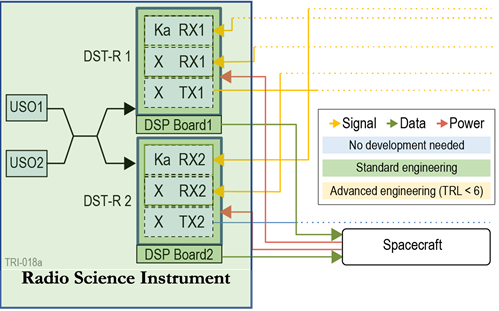TRIDENT Radio Science Objectives and Expected Performance
- 1University of Bologna, DIN - Aerospace Division, Forlì, Italy (paolo.tortora@unibo.it)
- 2Jet Propulsion Laboratory, Pasadena, CA 91109-8099, USA
- 3Weizmann Institute of Science, Rehovot 76100, Israel
- 4Lunar and Planetary Institute/USRA, Houston, TX, USA
- 5Southwest Research Institute, Boulder, CO, USA
Introduction and Background
Trident is a mission concept to investigate Neptune’s large moon Triton, an exotic candidate ocean world at 30 AU (Prockter et al., 2019, Mitchell et al. 2019). The concept is responsive to recommendations of the recent NASA Roadmap to Ocean Worlds study (Hendrix et al., 2019), and to the 2013 Planetary Decadal Survey’s habitability and workings themes (Squyres et al., 2011).
The concept was chosen (Ref. 5) from proposals submitted in 2019, under NASA’s Discovery Program, and is currently in its Phase A, competing for selection with three other mission concepts.
Voyager 2 showed that Triton has active resurfacing with the potential for erupting plumes and an atmosphere. Coupled with an ionosphere that can create organic snow and the potential for a subsurface ocean, Triton is an exciting exploration target to understand how habitable worlds may develop in our Solar System and beyond. Using a single flyby, Trident would map Triton, characterize active processes and determine whether the predicted subsurface ocean exists.
Nominal mission
By launching during 2026, Trident would take advantage of a rare, efficient gravity-assist alignment, to capitalize on a narrow – but closing – observational window that enables assessment of changes in Triton’s plume activity and surface characteristics since Voyager 2’s encounter one Neptune-Triton season ago.
We have identified an optimized solution to enable a New Horizons-like fast flyby of Triton in 2038 that was proved to fit within the Discovery 2019 cost cap. The spacecraft has a robust design and uses high heritage instruments: (a) Infra-red spectrometer, (b) Narrow angle camera, (c) Wide-angle camera, (d) Triaxial magnetometer, (e) Radio science and (f) Plasma spectrometer. The mission concept builds on the New Horizons concepts of operation. Our overarching science goals are to determine: (1) if Triton has a subsurface ocean; (2) why Triton has the youngest surface of any icy world in the solar system, and which processes are responsible for this; and (3) why Triton’s ionosphere is so unusually intense.
Radio Science Instrument and Objectives
The Radio Science Instrument (RSI) is the assembly of the DST-R (Deep Space Transponder and Receiver) and USO (UltraStable Oscillator), see Fig. 1.

Fig. 1: Trident’s Block Diagram of the Radio Science Instrument
The RSI hardware involves no new technology or advanced development. The DST-Rs are provided by the Italian Space Agency (ASI). Dual USOs identical to the USO provided for the ESA/JUICE mission 3GM radio science experiment, are provided to ASI by the Israel Space Agency. ASI has a wide experience in providing RF instrumentation having led the development of several transponder units for deep space science missions in the last 30 years.
The USO feeds the DST-R and generates a stable frequency reference for the uplink radio signals to be recorded on board. The DST-R works at the same time as a phase-coherent Deep Space Transponder at X-band, but also as an on-board Receiver at X- and Ka-band.
The RSI contributes to two Trident science questions related to the science goals (1) and (3): “Is Triton an ocean world?” and “Why is Triton’s ionosphere so intense?”.
In particular, the RSI provides three physical parameters: (a) the electron density profiles on leading and trailing hemispheres, (b) temperature via neutral atmospheric density profile, and (c) the thickness of the hydrosphere from internal mass distribution. Physical parameters (a) and (b) are estimated through simultaneous, dual frequency (X-and Ka-band) uplink radio occultations while the physical parameter (c) is inferred by gravity science observations carried out via phase-coherent Doppler tracking at X-band.
Our quantitative requirements for the three above-mentioned objectives (a), (b) and (c) are as follows:
- measure the electron density in the ionosphere of Triton to +/- 10% of the population detected by Voyager, i.e. to a sensitivity of 4E+9 el/m3;
- measure the neutral atmosphere density and temperature to a sensitivity of +/- 0.1 Pa and +/- 5 K;
- measure the gravity quadrupole coefficient C22 with ≤10% error.
This paper shows how an optimal combination of on-board instrumentation, a careful trajectory design and an efficient radio science data processing strategy will lead to exceeding all quantitative radio science requirements listed above, with ample margins.
Acknowledgements
Authors PT, AB, LGC and MZ acknowledge financial support from Agenzia Spaziale Italiana (ASI), via contract No. 2020-13-HH.0 CUP F34I20000050005. This work was carried out in part at the California Institute of Technology, Jet Propulsion Laboratory under a contract from NASA. It describes a predecisional mission concept, for discussion and planning purposes only. The inputs of the various past and present members of the Trident team are gratefully acknowledged.
References
[1] L. M. Prockter, et al.: Exploring Triton with TRIDENT: a Discovery-Class Mission, 50th Lunar and Planetary Science Conference 2019 (LPI Contrib. No. 2132), Abstract 3188.
[2] K. L. Mitchell, et al.: Implementation of TRIDENT: a Discovery-Class Mission to Triton, 50th Lunar and Planetary Science Conference 2019 (LPI Contrib. No. 2132), Abstract 3200.
[3] Hendrix, A. R. et al. (2019) Astrobiology 19(1), doi:10.1089/ast.2018.1955.
[4] Squyres, S. W. et al. (2011) Vision and Voyagers for Planetary Science in the Decade 2013-2022, National Academies Press.
[5] https://www.nasa.gov/press-release/nasa-selects-four-possible-missions-to-study-the-secrets-of-the-solar-system
How to cite: Tortora, P., Oudrhiri, K., Bourgoin, A., Gomez Casajus, L. A., Zannoni, M., Buccino, D., Kaspi, Y., Galanti, E., Frazier, W., Prockter, L., Mitchell, K., and Howett, C.: TRIDENT Radio Science Objectives and Expected Performance, Europlanet Science Congress 2020, online, 21 Sep–9 Oct 2020, EPSC2020-1042, https://doi.org/10.5194/epsc2020-1042, 2020.

